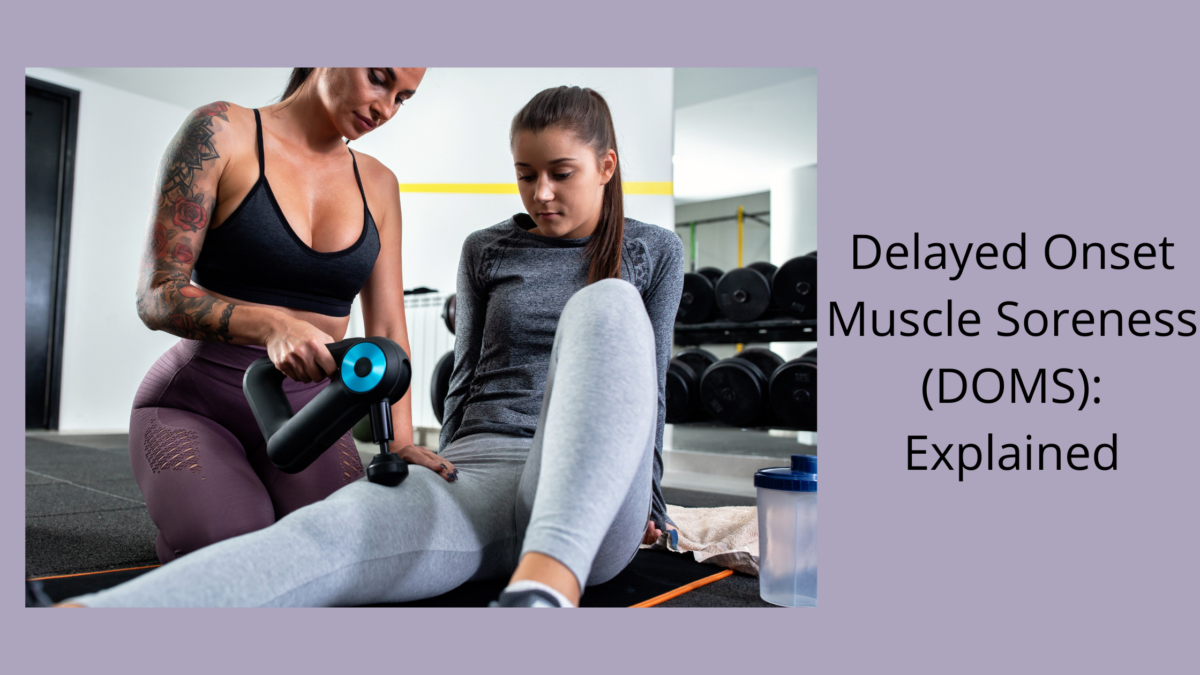Kassidy Covert, SPT – Texas State University, Doctorate of Physical Therapy Class of 2023
Physical activity and regular exercise are strongly recommended for one’s overall health and wellness. Benefits include decreasing the risk of chronic health conditions such as heart disease and type II diabetes, as well as improving cognition, mental health, sleep, and overall quality of life.1 However, there are times when a day or two after exercising we might feel a dull ache in our muscles whenever we move and wonder “I thought physical activity was supposed to make me feel better. Did I do something wrong?” Not necessarily! You may be experiencing Delayed Onset Muscle Soreness (DOMS), which is a normal response to exercise.
Muscle soreness can be described as a dull, achy, or tight feeling within muscles, during which peak discomfort occurs within 24-48 hours after activity.2-5 Soreness can be a normal response when starting an exercise program for the first time, performing a new activity, or progressing an activity in intensity.2-5 Whenever you perform a new activity, you are putting mechanical stress on muscle fibers, causing them to break down after the activity.3-5 The good news is that your body typically responds by repairing the muscle fibers and by making them even bigger and better than they were previously.3 Over time, the muscles adapt to the new stresses placed upon them, resulting in decreased soreness when you perform the activity again.2,3 Muscle adaptation also results in the larger, more toned muscle shape that often is a goal of resisted activity training.
Remember that the phrase “no pain, no gain” does not apply to every situation. The truth is that a healthy, gradual amount of stress applied onto muscle tissue is beneficial.2-4 Sometimes when starting a new activity, a common mistake is increasing intensity too quickly.4 If muscle soreness lasts longer than 72 hours or impedes your ability to perform daily activities, then the intensity of the activity needs to be scaled back.2,3 The keys to adherence of regular physical activity are gradual progression of intensity and use of optimal form during exercise. It is important to distinguish between tissue injury and soreness. Symptoms of tissue injuries include sharp pain that is constant, pain that comes on immediately after an activity or which does not resolve on its own in 7-10 days, or localized tissue swelling.2,3 Signs of a tissue injury should be evaluated by a medical professional such as a physical therapist.
Symptoms associated with soreness should go away within 3-5 days.2-5 There are some things that can be done to help alleviate the discomfort as you are recovering. Complete rest is not recommended as this can actually worsen the pain.2 Performing light massage, foam rolling, and/or light aerobic activities such as walking can help reduce muscle soreness by increasing body temperature and blood flow to tissue to allow for recovery. 2-6 Can you work out while being sore? Sure, you can work out the same area to a lesser intensity or ideally work on a different part of the body while recovering.2,4 Performing a variety of different forms of physical activity can allow you to work different parts of your body and allow for appropriate rest time.4 Variations of physical activity can include resistance training, yoga, Pilates, walking/running, utilizing cardio machines, playing sports, fitness classes, dancing, etc. If you have questions about how you can exercise safely and successfully, consult with your physical therapist. Physical therapists are movement experts who can help you adjust your exercise program and advise you on progressions according to your activity levels!
References:
- American Heart Association. American Heart Association Recommendations for Physical Activity in Adults and Kids. American Heart Association. https://www.heart.org/en/healthy-living/fitness/fitness-basics/aha-recs-for-physical-activity-in-adults. Published April 18, 2018. Accessed July 28, 2022.
- Maitland M, Zachazewski J. Soreness vs pain: What’s the difference? Choose PT. https://www.choosept.com/health-tips/soreness-vs-pain-whats-difference. Published August 12, 2021. Accessed July 28, 2022.
- Krum NL. Understanding muscle soreness – how much is too much? National Kidney Foundation. https://www.kidney.org/content/understanding-muscle-soreness-%E2%80%93-how-much-too-much. Published July 2, 2015. Accessed July 28, 2022.
- McCallum K. Should you still work out when you’re sore or in pain? Houston Methodist on Health. https://www.houstonmethodist.org/blog/articles/2022/mar/should-you-still-work-out-when-youre-sore-or-in-pain/. Published March 14, 2022. Accessed July 28, 2022.
- Nahon RL, Silva Lopes JS, Monteiro de Magalhães Neto A. Physical therapy interventions for the treatment of delayed onset muscle soreness (DOMS): Systematic review and meta-analysis. Physical Therapy in Sport. 2021;52:1-12. doi:10.1016/j.ptsp.2021.07.005
- Hjert CS, Wright CJ. The Effects of Self-Myofascial Release Foam Rolling on Muscle Soreness or Pain After Experiencing Delayed Onset Muscle Soreness: A Critically Appraised Topic. International Journal of Athletic Therapy & Training. 2020;25(6):294-298. Accessed July 28, 2022. https://doi.org/10.1 123/ijatt.201 9-0078

